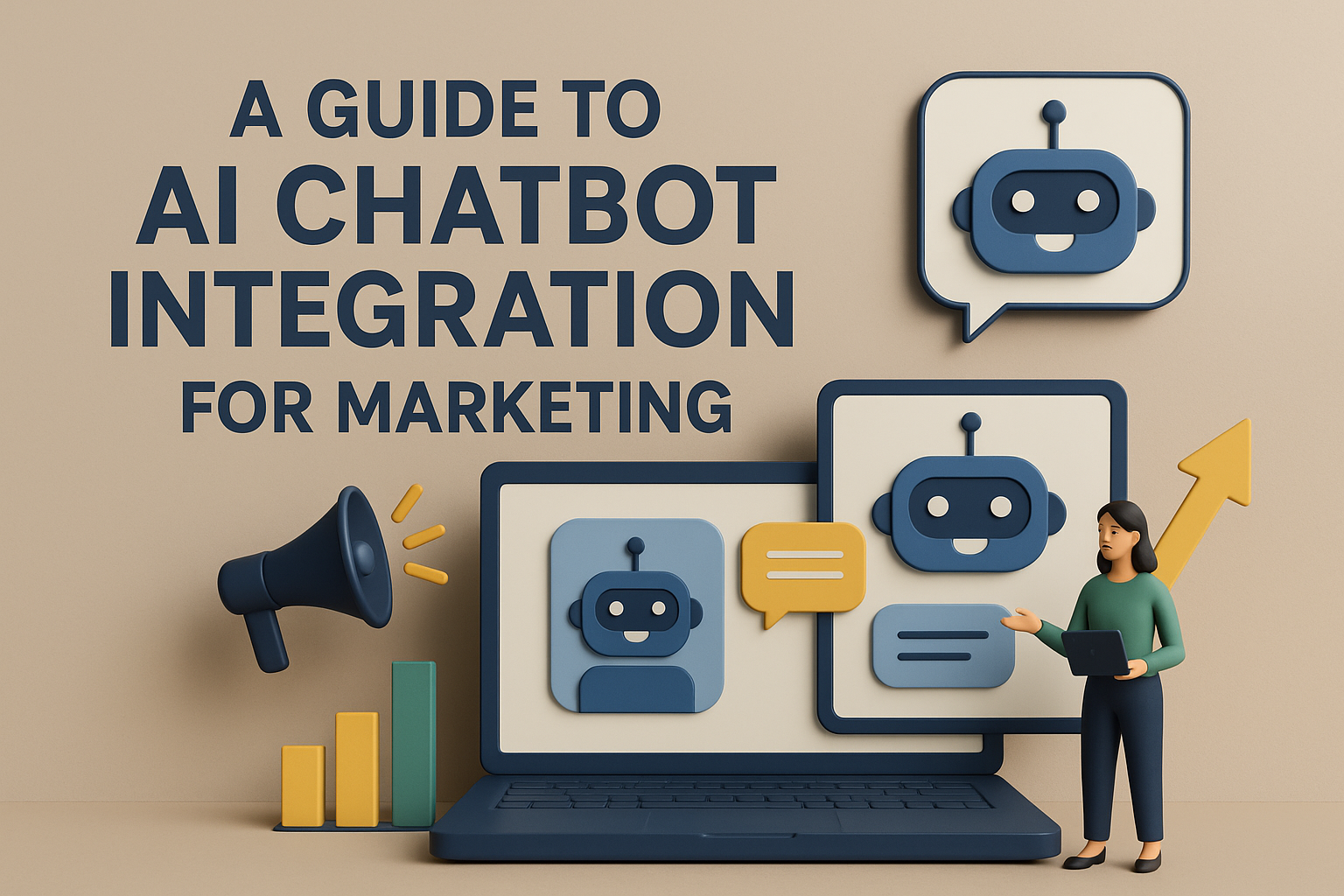Today’s business landscape is more dynamic than ever before, and customers expect nothing less than quick answers, personalised attention, and continuous, 24/7 support.
Ticking all the boxes of customer support can seem like a superhuman effort for any marketing organisation. This is where AI chatbots can be really useful.
You’ve likely used them before — those little chat windows that pop up on websites, offering some online assistance or selling you something. But today’s AI chatbots are much more advanced than crude, automated scripts. They are smart digital assistants that can transform your marketing and business as a whole, by elevating the brand experience you offer, making it more accessible, effective and customer-focused.
But an AI chatbot should not be seen as a replacement for human interactions, but as an addition. It’s like having an extra member of the team who never sleeps, never gets tired and can handle hundreds of conversations at once — all while learning and getting smarter with every interaction.
Let’s understand what AI chatbot integration for marketing is all about and why businesses are using this increasingly key tool.

What is an AI Chatbot in Marketing?
Basically, an AI chatbot is a software application that mimics human conversation, usually in text format or through speech. A chatbot uses artificial intelligence methods like Natural Language Processing (NLP) to be able to interpret what a user is asking, even when those words aren’t perfect, and then respond intelligently.
In a marketing sense, these chatbots are embedded on your website, social channels (including messaging apps) and even email campaigns. They are there to interact with leads and customers, walk them through the process of finding what they are looking for (if they’re already a customer), and help you earn repeat business.
The AI Chatbots That Power Up Your Marketing
Adding AI-powered chatbots to your digital platforms isn’t just a fad– it ensures a competitive edge, and the benefit becomes evident when examining its efficiency at different stages of the marketing funnel.
24/7 Customer Service:
Picture this: the visitors on your website have questions at 2 o’clock in the morning. Without a chatbot, they may leave your site, never come back to their question, or even go to one of your competitors. Of course, you may not be able to handle their queries at such odd hours, but an AI assistant can. It is your “never sleeping” assistant.
They offer 24/7 instant responses to frequently asked questions about your products, services, pricing or policies. This around-the-clock availability significantly enhances the customer experience and guarantees that you’ll never miss an opportunity to do business due to time differences or off-hours.
Lead Generation & Qualification
Lead management is one of the best marketing use-cases for chatbots.
Rather than passively waiting for someone to complete a lengthy form, chatbots can get out in front and engage your visitors on the page. It can inquire its way to find out (“What are you seeking? “What’s your budget?” “What industry are you in?”) to learn about their needs and see if they’re a good match. If they are, the chatbot can collect their information and even book a call for them with your sales team, while providing all of their conversation history. That way, your sales team is dealing with better-end pre-qualified leads.
Personalisation at Scale:
Modern consumers expect personalised experiences. Chatbots also shine here.
Integrating with your customer relationship management (CRM) solution, a chatbot will be able to pull up past orders, browsing behaviour or expressed preferences. It can then leverage this knowledge to make tailored product recommendations, surface personalised content or even welcome them by name. Customers who feel that they are being understood and appreciated on a personal level will be far more loyal to their brand.
Sales Support & Conversion Boosting:
Chatbots serve as virtual sales agents. They can walk users through your product catalogue, help explain features, compare options and address specific questions. For e-commerce companies, they can even help recapture abandoned shopping carts by providing support or a special deal.
Not only is a chat interface more user-friendly, but you can let users complete simple calls to action (e.g. buy tickets, book a meeting room) on the chat, making it even easier for them to click and convert!
Collecting valuable Data and Insights
Each of these conversations is a goldmine of data for chatbots. It collects frequently-asked questions, user pain points and popular product inquiries, as well as how users ask for their needs. This data analysis can offer valuable insights into what your audience likes and dislikes, what they are still missing and why your website content or product descriptions could be too cryptic. This feedback is essential for you to work on your marketing, enhance your offering and optimise your website.
Cost Efficiency & Scalability:
A high volume of repetitive customer requests that are processed manually can be costly and labour-intensive. Chatbots facilitate this, bringing down the cost for customer service and sales activities by a considerable margin. AI chatbots won’t be overrun, reliably managing hundreds—or even thousands—of conversations at once. Your marketing capacity becomes instantly scalable.”
Consistent Brand Voice (Always On-Brand):
A bot could be trained to speak in a style and tone specific to your brand. In this way, every automated encounter is consistent with your brand and message, helping to form a cohesive voice across all brands.
How to Incorporate AI-Powered Chatbots into Your Marketing Strategy
Creating an AI chatbot isn’t something you can simply “set it and forget it” either. It is a product of careful planning, and it also needs to be perfected over time.
Define Your Goals:
Before you even start looking at platforms, figure out what you’d like your chatbot to do. Is it to cut down on customer support calls? Improve leads? Boost e-commerce conversions? Define specific objectives that will determine the design and functions of your chatbot.
Choose the Right Platform:
Chatbot platforms vary from simple, rule-based bots to sophisticated conversational AI platforms. Look for one that offers powerful AI features, ease of integration, customisation and analytics.
Define User Journeys and Conversation Flows:
Predict the common questions and discussions users will have with the chatbot. Design clear, step-by-step dialogue flows to guide the user smoothly toward their goal. Always prioritise building out responses for the most frequently asked questions first. And don’t forget to create smooth pathways for the chatbot to recognise and hand over complex requests to your human team.
Train Your Chatbot with Good Data:
A chatbot is only as smart as the data it’s trained on. Just feed it with your FAQs, knowledge base articles, product descriptions, marketing copy and examples of typical customer interactions. The more it knows, the better it understands and responds.
Integrate with Your Existing Tools:
Connect your chatbot to your CRM (HubSpot, Salesforce) and email marketing software, as well as any other marketing software you are using. This critical integration ensures that lead information flows instantly and accurately, conversations are personalised, and follow-ups are automatically triggered.
Implement a Human Hand-off Strategy:
There are questions even the smartest AI chatbot won’t be able to answer. Define clear triggers for the chatbot to smoothly transfer the conversation to your human team.
Make sure the live agent can see the entire chat for context that’ll keep things moving in a customer-friendly way.
Monitor, Analyse, and Optimise Continuously:
Launch is just the beginning. Regularly review your chatbot’s performance.
- What isn’t it answering?” (Add new training data or flows).
- Where are users dropping off? (Refine the conversation path.)
- Are the responses clear and useful? (Adjust wording.)
- Is it meeting your KPIs? (Make iterative improvements.)
This continuous optimisation is important to be able to take advantage of its true power.
Choose Your Chatbot Platform
There are two main routes, but most businesses use the second:
| Option | Description | Best For |
| No-Code/AI Platforms | Tools like HubSpot, Intercom, or dedicated AI chatbot builders (e.g., Botsonic, Collect.chat). You train the bot with your data and get an embed code. | Most Businesses (Fastest and Easiest) |
| Custom Development | Building the chatbot from scratch using programming languages (Python, JavaScript) and AI frameworks (like Dialogflow or Rasa). | Large enterprises with highly complex or unique needs. |
The Future is Conversational
AI chatbot integration is more than just a time-saving tool; it’s about embracing the future of customer engagement.
As AI technology matures, chatbots will become even smarter, offering capabilities like seamless, naturally empathetic conversations. This evolution will be critical for delivering the integrated, highly personalised experiences that customers expect.
By strategically incorporating AI chatbots, you aren’t just automating tasks—you’re hardwiring a responsive, intelligent, and customer-centric marketing engine. This engine works tirelessly to engage, convert, and delight your audience with greater efficiency than traditional methods.
Ready to deploy your marketing superhero?


